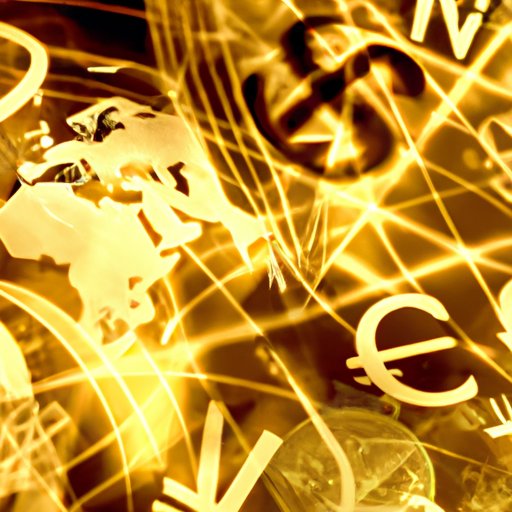
Introduction
Have you ever wondered how much money there is in the world? With so much wealth concentrated in the hands of a few, it can be difficult to comprehend the scale of global financial assets, let alone the wealth that exists in natural resources, goods and services produced, and other forms of currency beyond paper money. Understanding the various forms of wealth and their combined value is crucial for both individuals and governments in navigating the global economy and planning for the future.
Counting the World’s Wealth: A Deep Dive into Global Financial Assets
Global financial assets, which include stocks, bonds, real estate, and other securities, are estimated to be around $360 trillion. This represents the value of financial assets held by individuals, corporations, and governments around the world. When combined with other forms of wealth, the total estimated value of wealth on earth is around $900 trillion. However, it is worth noting that this estimate is constantly changing due to factors such as currency fluctuations, changes in asset values, and unexpected events such as natural disasters.
While $900 trillion may seem like an enormous amount of wealth, it is important to keep in mind that global debt levels are also increasing. As of 2019, global debt is estimated to be around $253 trillion. This means that the total amount of wealth on earth is not evenly distributed and that many individuals, corporations, and governments are living beyond their means, which can have significant economic consequences.
From Gold Bars to Cryptocurrency: The Many Forms of Currency and Their Combined Value
Despite the rise of digital currencies such as Bitcoin and Ethereum, traditional fiat currency remains the primary means of exchange around the world. However, there are other forms of currency such as commodity currency, which is based on valuable natural resources such as gold or oil, and cryptocurrency, which exists solely in digital form. When all forms of currency are combined, their total value is estimated to be around $90 trillion, which represents a significant proportion of global wealth.
The value of currency is constantly changing due to factors such as inflation, supply and demand, and government policies. Currency fluctuations can have a significant impact on the estimated value of global wealth, as seen in the recent fluctuations in the value of Bitcoin and other cryptocurrencies.
The Billionaires’ Club: A Look at the World’s Richest People and Their Fortunes
According to Forbes’ Annual Billionaires list 2021, there are over 2,755 billionaires around the world with a combined net worth of around $13.1 trillion. This means that the wealthiest individuals hold a significant proportion of global wealth, with a small percentage of individuals holding a large percentage of total wealth. While the accumulation of wealth by the top 1% can contribute to economic growth and job creation, it can also exacerbate inequality and have negative social and economic impacts on the world as a whole.
The uneven distribution of wealth is a complex issue with no easy solution, but it is important for governments to consider strategies for promoting more equal distribution of wealth and ensuring that individuals have access to the resources necessary to thrive.
Hidden Treasures: The Value of Natural Resources Across the Globe
Natural resources such as oil, gas, and minerals have become increasingly valuable in recent years due to the rise of emerging economies such as China and India. The total estimated value of natural resources across the globe is around $50 trillion. However, the extraction and depletion of natural resources can have significant environmental and economic impacts, including pollution, climate change, and resource depletion.
As the world’s population continues to grow and demand for natural resources continues to increase, it is crucial for governments and corporations to consider the long-term impacts of their actions on the environment and the world as a whole.
The State of Global Debt: A Look at National and International Debt Levels
Global debt levels have been on the rise in recent years, with both individuals and governments taking on more debt. As of 2019, global debt levels were estimated to be around $253 trillion. This represents a significant amount of financial burden, particularly for countries with high levels of debt.
While debt can be a useful tool for financing investments and promoting economic growth, high levels of debt can also have significant economic consequences such as inflation, decreased economic growth, and decreased access to credit. It is important for governments to carefully consider the implications of taking on debt and to develop strategies for managing and reducing debt levels.
The Price of Everything: Examining the Value of Goods and Services Produced Globally
The value of goods and services produced globally is an important component of total global wealth. According to the World Bank, the total gross domestic product (GDP) of the world in 2019 was around $88 trillion. This represents the combined value of all goods and services produced within a given time period.
Calculating the value of goods and services produced globally can be a challenging task, as it requires accurate data from a wide range of sectors and industries. It is important for governments and organizations to consider the limitations of these estimates and to develop strategies for accurately measuring and evaluating global production.
Conclusion
Understanding the various forms of wealth and their combined value is crucial for navigating the global economy and planning for the future. From global financial assets to natural resources and the value of goods and services produced, the world’s wealth is constantly changing and evolving. Governments, organizations, and individuals must work together to ensure that wealth is distributed fairly and used responsibly to promote economic growth and social well-being.
As we continue to grapple with economic challenges such as debt, inequality, and environmental degradation, it is important for individuals to stay informed and engaged on these important issues and to advocate for policies and practices that promote a more equitable and sustainable global economy.





